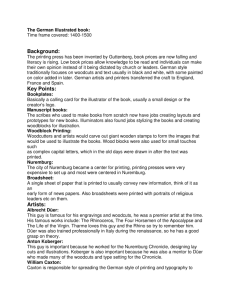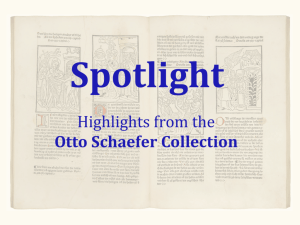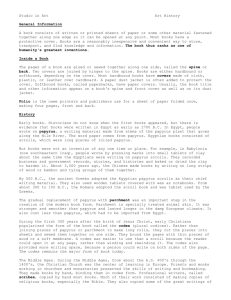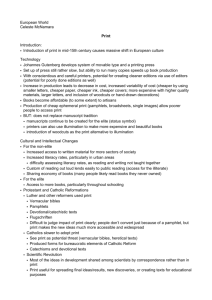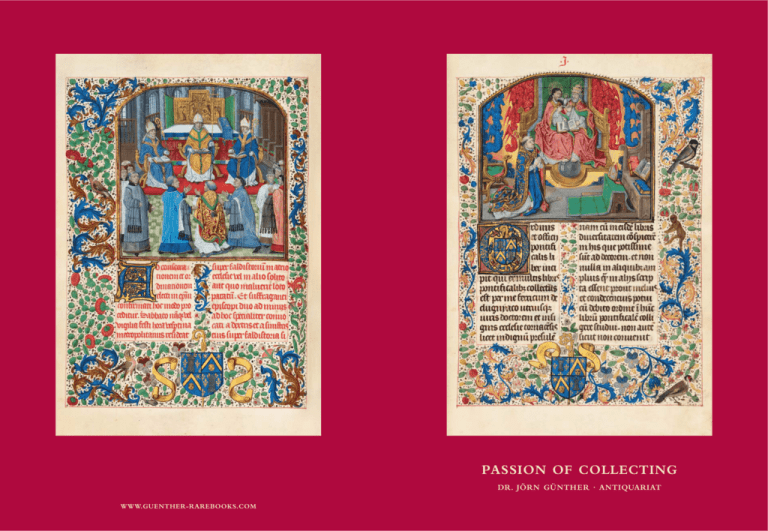
PASSION OF COLLECTING
DR. JÖRN GÜNTHER · ANTIQUARIAT
WWW.GUENTHER-RAREBOOKS.COM
PASSION
OF
COLLECTING
A SELECTION
OF
ILLUMINATED MANUSCRIPTS
•
MINIATURES
•
EARLY PRINTED BOOKS
BROCHURE NO. 11
Dr. Jörn Günther · Antiquariat
Baron-Voght-Straße 27
22609 Hamburg / Germany
Phone +49(0)40 822510
Fax +49(0)40 82251200
info@guenther-rarebooks.com
www.guenther-rarebooks.com
Full descriptions of all items are available on request.
All items offered in this catalogue are subject to prior sale.
Printed in Germany
© Copyright 2009 Dr. Jörn Günther · Antiquariat
39 Der Antichrist und die fünfzehn Zeichen. Block-book. Nuremberg: Hans Sporer, 1470. 290 x 195 mm. 38 leaves,
complete. Partly coloured woodblock print with 54 illustrations. – The only known copy of the second block-book edition.
The popular book consists of a picture cycle with explanatory text. It relates the life of the Antichrist, a false prophet, whose
dubious miracles and untrue teachings form a negative parallel to the life of the Saviour. His defeat is followed by the ‘Fifteen Signs
of Doomsday.’ It depicts the Last Judgement in alarming detail in order to kindle the reader’s fears and summon him to penitence.
The well-balanced woodcuts with dark outlines give the work a direct and pointed expressiveness. The Antichrist had been spread
via all media: manuscript picture-books, block-books and eventually incunabular prints. All block-book editions are extremely rare.
40 Ars memorandi. Block-book. [Nuremberg (?), c. 1470.] 287 x 201 mm. 30 leaves, complete. Woodblock print with 15
full-page illustrations. – First print of first edition, one of only two known copies. The book addresses young theologians of moderate
education. It is intended to serve as an aide-memoire to the content of the four Gospels. Images and text are presented opposite
one another so as to be mutually explicable. Mnemotechnical tools of this kind were especially popular with the Dominicans.
Both the richly illustrated contents and the technique of production lend a special appeal to block-books: Illustration and text
are cut into a wood panel, which is then printed onto paper using the rubber-printing technique. The sheets were printed on
one side only, then usually pasted together against their blank versos in order to make them look like ‘real books,’ like in our copy.
41 Plenarium (German). – Evangelien und Episteln: ... Hie vachet sich an ein plenari ... Augsburg: Johann Bämler,
20 September 1474. 312 x 218 mm. 368 numbered leaves: [1], i-clxvi, i-clxxxxix, [1 blank]. With 56 (2 full-page) woodcuts from 48 blocks and 54 Maiblumen-initials in contemporary colouring. – Third edition, first by Bämler. Presenting the
life of Christ through scripture, the Plenarium is a product of the religious atmosphere of the 14th and 15th centuries spawned
by the ‘devotio moderna’. The Evangelia und Epistel offer German versions of the Plenarium which comprised the liturgical
readings from the Gospels (with glosses), followed by the Epistles read in the Mass, all arranged according to the church
calendar. Richly adorned by woodcut illustration the text could also be understood visually without verbal expression.
Unsurprisingly the Plenarium became a seller: Günther Zainer’s first edition (Augsburg 1473) was followed by let
alone 57 editions in High German and two dozen editions in Low German. The illustration of the present very early
edition has been copied from Zainer’s and has been executed by two different hands. One of the cutters was also
responsible for the two amazing full-page woodcuts, which Schmid counted among Bämler’s best illustrations: a Salvator
Mundi on fol. 1a and the Entombment of Christ on fol. 168b. Johann Bämler was one of the most prolific printers in
Augsburg. Very rare: Only eight other complete copies are known, and some are variants showing the Resurrection
instead of the Entombment. A fine and very large copy with many uncut leaves, in a contemporary Augsburg binding.
42 Jean d’Arras. L’Histoire de Melusine. [Lyon: Martin Huss, c. 1480.] 278 x 196 mm. 111 (of 184?) leaves, with 30 (of
63?) nearly full-page woodcuts. – Second French edition. One of the first illustrated books printed in France. The legend of
the union between a mermaid and a young nobleman has its origin in southern France around the year 1200. The genealogical
potential of this theme was used in France in order to narrate the tale of Melusine as the legend of the foundation of the
House of Lusignan, which bears a mermaid with a fishtail in its coat-of-arms. Jean d’Arras wrote the first literary version of
the theme as a novel in prose after 1392 upon commission of Jean Duke of Berry. Around 1401-03 the Poitivine poet
Couldrette composed a novel in verse, which formed the base for the German translation, while the French incunable editions
go back to the version of Jean d’Arras. Splendid, near full-page woodcuts illustrate the adventurous tale. The figures, integrated
with their dynamic movements into the narrow picture space, underline the dramatic of the individual scenes in an impressive
way. The woodcuts have been used before only in the second German edition, Melusina, printed c. 1476 by Bernhard Richel
in Basel. Martin Huss had learned his profession in Basel, and there he had acquired Richel’s woodcuts to print the first French
illustrated books. Our edition of the French text is preceded only by that of Adam Steinschaber of Geneva, dated 1478. Only
six French incunable editions of the Melusine are known to have survived in but very few and mostly incomplete copies.The copy
at hand is the only one of this edition, preserved in a contemporary English binding from the workshop of Caxton’s First Binder.
43 Vita Christi: Gaistliche ußlegong des lebe(n)s Jhesu Cristi. [Ulm: Johann Zainer, c. 1482.] 268 x 197 mm. 178 leaves,
complete. 95 (7 full-page) woodcuts from 88 blocks in the text and numerous woodcut initials, all in contemporary colouring. – First edition. This devotional book contains a German interpretation of the Life of Christ, based on the Vita Christi
of Ludolphus Carthusiensis (or Ludolph of Saxony) and other sources. Ludolph (c. 1300-1378) first joined the Dominican
order, later he lived in the charterhouses of Strasbourg, Coblentz and Mainz, where he composed his major work, Vita
Christi. The text comprises more than the story of Jesus’s life, as it adds christological reflections and prayers to every incident.
In addition to his monasterial brethren, Ludolph intended to address with his text all those interested in religious questions,
even the laity. Especially the vernacular translations of the text spread considerably. However, the German adaptations, like the
present edition, still deserve further research. The 95 woodcuts are at least by four hands and obviously were not produced
for this book originally. The heterogeneous designs of the cuts are harmonized by surrounding border lines printed in some
distance from each block. As a result, many illustrations appear larger than they are. Johann Zainer, the first printer in Ulm, is
well known for his earlier large illustrated books, e.g. the famous Ulm Aesop (c. 1476). Despite a lack of money he printed
the Geistliche Auslegung and tried to recall those better times, intending to prove that he still was able to produce a comprehensive illustrated book. However, he had to sell considerable parts of his typographic material afterwards. Extremely rare.
44 Collection of four rare incunabula – I. Directorium statuum. Seu verius. Tribulatio seculi. [Strasbourg]: Peter
Attendorn [after 25 October 1489]. 196 x 140 mm. 36 leaves, complete. With 3 full-page woodcuts. – Only edition of this
collection of short, sometimes satirical treatises, sermons and aphorisms all dealing with the degeneration of the lower clergy as
well as of university students. II. Johannes Mösch. Tractatus de horis canonicis dicendis. Augsburg: Anton Sorg, 1489. 60
leaves. Second edition. III. [Pseudo-] Aristoteles. Problemata. Probleumata Arestotelis. – Vita et morte. Cologne: Heinrich
Quentell, c. 1490. 50 leaves. A compilation of scientific and medical texts. IV. [Pseudo-] Seneca. De quattuor virtutibus cardinalibus (sive) De formula honeste vite. Leipzig: Konrad Kachelofen, c. 1490. 24 leaves. With a German translation in verse.
45 Jacobus Philippus [Foresti] de Bergamo. De plurimis claris selectisque Mulieribus. Ferrara: Laurentius de Rubeis
de Valentia, 29 April 1497. 313 x 211 mm. 176 leaves, complete. Xylographic title, 2 large woodcuts, 3 architectural borders,
172 woodcuts in text (from 56 blocks), printer’s device. – First edition. In imitation of Boccaccio’s De claris mulieribus the
Augustinian Giacomo Filippo de Bergamo (1434-1520) wrote this work on women famous in history and mythology.
As shown in the first illustration, it is dedicated to Beatrice of Aragon, widow of Matthias Corvinus. A vignette portrait,
mostly set in a landscape, accompanies each biography. Some of them are rendered with such vivid detail as to be thought
genuine likenesses, e.g. that of Bianca Maria Visconti or Ginevra Sforza. A classic of Italian Renaissance book illustration.
46 Ars moriendi. [Leipzig: Konrad Kachelofen, c. 1495/98, not after 1498]. 208 x 141 mm. 14 leaves, complete.
14 full-page woodcuts. Seventh Latin edition, fourth by Kachelofen. ‘The art of dying’ provides practical and spiritual
aid to prepare for one’s death even without a priest. The text was very popular during the 15th century and was first
printed as block-book. Kachelofen printed five editions with the original Latin text (and also three German editions)
and illustrated them with reduced copies from the famous block-book series. The woodcuts depict the temptations by
the devil, opposed to good advice and admonitions from the angels and finally, the spiritual recovery of the dying man.
For his Latin editions, Kachelofen added three new illustrations: auricular confession, extreme unction and Archangel Michael.
47 Ars moriendi. Landshut: Johann Weissenburger, 1514. 192 x 134 mm. 14 leaves, complete. 14 full-page woodcuts
(1 repeated).Very scarce edition, the only one printed in Landshut. While the illustrated Ars moriendi had been immensely
successful during the 15th century when it was printed in several block-book and incunable editions, only very few
reprints appeared in the 16th century. The illustrations of Weissenburger’s edition follow the examples from the incunable
age. However, the depictions of the temptations and good advice as well as the final illustration are significantly simplified compared to earlier woodcut versions. In return, the full-page illustrations are framed with borders consisting of
various decorative elements. Coming from Nuremberg, Weissenburger started the first printing press in Landshut in 1513.
48 Joannes de Ketham. Fasciculus medicinae. Venice: Joannes et Gregorius de Gregoriis, 15 October 1495.
318 x 215 mm. 40 leaves, complete. With 10 full-page original coloured woodcuts and numerous woodcut initials. –
Second Latin edition, the fourth overall. Johannes de Ketham (fl. 1455-1470, professor of medicine in Vienna), the
ostensible author of this book, used this collection of short tracts of various medical subjects for his lectures and
recommended it to his pupils. However, the texts had already begun circulating in manuscript during the 13 th century.
The topics covered include surgery, epidemiology, urology, herbal remedies, obstretics and gynaecology, and anatomy.
Ketham’s ‘medical miscellany’ remained authoritative for fifty years and – due to its woodcuts – influential for long
beyond that. The Gregorii brothers first published the famous compilation in 1491. It was illustrated with six woodcuts
and is considered as the first printed book to contain anatomical illustrations. For the second, vernacular, edition,
four new woodcuts depicting a surgeon’s activities were added. These are associated to the circle of Gentile Bellini
and recognized as the first realistic figures to appear in a medical book. They show the famous Padua physician Petrus
de Montagnana lecturing from his pulpit, Petrus and his students with attendants carrying urine jars, a doctor
treating a plague victim, and Mundinus lecturing on dissection. The woodcuts of the earlier Italian edition from the
same press were reused here, with the exception of the illustration of the dissection, which has been newly cut.
49 [Niccolò da Poggibonsi.] Viazo da Venesia al Sancto Iherusalem et al monte sinai sepulcro de sancta chaterina …descrito.
Bologna: Giustiniano Rubiera, 6 March 1500. 313 x 209 mm. 68 leaves, complete. Woodcut on title, full woodcut border,
144 woodcuts in text, printer’s device. – First edition of the first printed Italian guidebook to the Holy Land. About 1350 the
Franciscan Niccolò da Poggibonsi wrote the earliest Italian account of a pilgrimage to Jerusalem, the Libro d’oltramare. Curiously,
neither text nor illustration of the present edition are based on an Italian manuscript but on a German translation of the 15th
century. The woodcuts show town views of Venice, Famagusta, Jerusalem, Bethlehem, Nazareth, Jericho, Damascus, Beirut,
Alexandria etc. and a lot of churches, tombs and holy places.This edition became a model for pilgrim’s guidebooks for centuries.
50 Hartmann Schedel. Das buch der Croniken unnd geschichten. Augsburg: Johann Schönsperger, 1500. 332 leaves:
numbered (1)-CCCXVII, [15]. With c. 2000 woodcuts after Michael Wolgemut and Wilhelm Pleydenwurff. – Third German
edition, the second of the so-called ‘Small Schedel’. Schönsperger’s reprint of the Nuremberg chronicle: reduced in text and size,
and with new woodcuts in a more painterly style. – Bound with: Petermann Etterlin. Kronica von der loblichen Eydtgnoschaft.
Basel: Michael Furter, 24 December 1507. 133 leaves: numbered [8], (1)-CXXIV. 28 woodcuts from 12 blocks by Master
DS et al. – First edition (second issue, after censorship). The first printed chronicle of Switzerland, including the oldest depictions of Lucerne and of Wilhelm Tell shooting the apple. – Two important chronicles united in a contemporary Ulm binding.
51 Albrecht Dürer. Imagines coeli Septentrionales cum duodecim imaginibus zodiaci. – Imagines coeli Meridionales.
Nuremberg, 1515. 445 x 610 mm. Two woodcuts (each c. 430 x 430 mm) with splendid original colouring. First
regular states. – Dürer’s celestial maps of the northern and southern hemispheres are the first ever printed scientifically
rigorous star charts. They were novel for the 16th century, combining accuracy of star-placement with classical constellation
figures. Dürer produced these charts under the patronage of Emperor Maximilian I, in cooperation with the mathematician
and court historian Johannes Stabius (after 1460-1522) and the astronomer Conrad Heinfogel († 1517). The planispheres
include a coordinate system and position the stars of the 48 constellations based on the star catalogue contained in
Ptolemy’s 2nd century Almagest. According to Ptolemaic tradition the twelve signs of the Zodiac are displayed on the northern hemisphere and are to be read counter-clockwise. That is, as seen from space, or as they would appear on a celestial
globe. The constellation figures are therefore shown from their back view. Dürer decorated the four corners of the northern chart by portraits of four ancient authorities, dressed in their assumed national dress, each holding a celestial globe:
Aratus, Ptolemy, Al-Sufi, and Marcus Manilius. The southern hemisphere is projected by using the same system, but it shows
distinctly fewer stars and constellations as the companion piece. Large areas of this map are vacant of constellations because
they were not visible from the Mediterranean or Middle East, the area where the sources of Ptolemy’s Almagest came from.
52 Albrecht Dürer. Etliche underricht. zu befestigung der Stett, Schlosz, und flecken. Nuremberg: H. Andreae, 1527.
308 x 199 mm. 26 leaves, complete. 21 woodcuts. Second edition, which appeared immediately after the first. –
Underweysung der Messung, mit dem Zirkel und richtscheyt. Nuremberg: H. Andreae, 1538. 93 leaves, complete. 183 woodcuts. Second German edition, enlarged by further text and woodcuts. – De Symmetria partium in rectis formis humanorum
corporum... Nuremberg: Dürer’s widow, 1532. 80 leaves, complete. 72 woodcuts (65 full-page). First Latin edition. –
Albrecht Dürer’s (1471-1528) three great artist’s manuals in one volume: his treatise on fortification, his fundamental analysis
of geometric perspective, and his highly influential study of human proportion in the translation by Camerarius (books I-II).
53 Albrecht Dürer. The Small Passion. [Nuremberg: Hieronymus Höltzel, c. 1511]. 37 plates, complete (Meder 125-161).
Title woodcut (186 x 80 mm) from the Latin edition with text on verso, 36 woodcuts (127 x 97 mm) in good early impressions
before and after the Latin text edition of 1511. Plates tipped by left side onto leaves (218 x 188 mm) and bound as a book. – Dürer’s
Small Passion series is considered his most unified series, executed with a simpler, more direct treatment of the subject. Moreover,
Dürer expanded the usual cycle of the Passion by preceding and subsequent scenes, beginning with the Fall of Man and ending with
the Last Judgement. Four of the woodcuts are dated 1509 and 1510; in 1511 the series was published as a book with Latin text on
the versos, the year in which also Dürer’s “three large books” appeared. Later impressions continued to be printed without text.
54 Andreas Vesalius. Anatomia Deudsch. Nuremberg: Julius Paul Fabricius, 1551. 392 x 295 mm. (2), 78 leaves.
Woodcut with Nuremberg arms on title, 40 etched anatomical plates. – First edition of the German translation of De
humani corporis fabrica libri septem (seven books on the structure of the human body), one of the most influential works in the
history of Western medicine. Vesalius (1514-1564) was appointed physician to Charles V. He is regarded as the founder of
modern ideas on anatomy. The German edition of 1551 contains an abridged version of his treatise. It was edited and probably also translated by the physician Jacob Baumann (1520-1586). Unlike the original illustrations the impressive anatomical figures in the German edition at hand are copper engravings, not woodcuts. A large copy in the publisher’s calf binding.
55 Notitia utraque cum Orientis tum Occidentis. Edited by Sigismund Gelenus. Basel: Hieronymus Froben and
Nicolaus Episcopius, 1552. 332 x 222 mm. 108 leaves, complete. Woodcut printer’s device, 105 woodcuts in full contemporary hand colouring. – First complete and illustrated edition. A collection of works on the late Roman Empire, including the
Notitia Dignitatum; an anonymous 4th-century tract De rebus bellicis, on the imperial army and ideas for new engines of war;
Beatus Rhenanus’ description of Illyricaum; Alciati’s De magistratibus civilibusque et militaribus officiis on Roman military and civil
organization; and others. The illustration is based on a lost Carolingian Greek manuscript, which in 1436 obviously was temporarily provided in Basel for copying. The Swiss painter and engraver Conrad Schnitt designed the majority of the woodcuts.
56 Cronica Cronicarum abbrege et mis par figures descentes et Rondeaulx. Paris: Jacques Ferrebouc for Jean Petit and
François Regnault, 20 September 1521. 550 x 365 mm (the last leaf 550 x 160 mm). 32 vellum leaves, printed on one
side only and joined to form a scroll about 11 metres long. With 92 woodcuts in fine contemporary colouring. – First edition
and the earliest printed scroll. A chronicle of French, English and world history, ranging from creation to the year 1521, when
it was printed in a truly extraordinary form. Four registers, one below the other, retrace the history and genealogy of popes
and emperors, the kings of France, England and Jerusalem, the dukes of Normandy and Brabant, and the counts of Flanders
and Hainaut. The way in which English history is featured, implies that the publishers planned to sell the work not only in
France, but also in England. The 92 coloured woodcuts include city views of Paris, London (repeatedly), Rome, Trier and Troy,
portraits of Henry VIII, François I, emperor Charles V and others, the twelve Apostles, Noah’s Ark and other Bible scenes; plus
hundreds of roundels in genealogical lines. Printing on one side of the leaf only and the design of a consecutive genealogical
tree arranged horizontally means that the archaic scroll format was planned for it from the beginning. The use of so expensive
material as vellum for a book of this dimension is another instance of deliberate archaism suitable to mark the importance
of this chronicle, although the work also appeared printed on paper. Most of the few surviving copies, of both materials, are
now pasted back to back and bound up as books. Thus, this is one of only four extant vellum scrolls, as far as we know today.
57 Leonhart Fuchs. De Historia Stirpium commentarii insignes. Basel: Michael Isengrin, 1542. 355 x 237 mm. 14 leaves,
896 pp., 2 leaves. 514 woodcuts by Veit Rudolf Speckle after Albert Meyer and Heinrich Füllmaurer in contemporary colouring probably by the publisher’s workshop. – First edition. One of the most celebrated herbals. In addition to describing plants
for their medical use, Fuchs also gives accurate botanical descriptions of more than 400 German and 100 foreign plants. Among
them are the first descriptions of recently discovered American plants, such as maize, pumpkin, chilli pepper, and snap bean.
The work is particularly important because of the size and beauty of the true to life woodcuts, aiming at an ideal concept, and
easy to remember. Remarkable is also that the three artists, who created the illustration, are portrayed at the end of the book.
58 Pierre Vallet. Le Jardin du Roy Très Chrestien Henry IV. [Paris]: Pierre Vallet, 1608. 336 x 225 mm. 78 leaves, with
74 engravings in contemporary colouring: title, one portrait (of 2), 72 (of 73) plates. – First edition. This important
florilegium is dedicated to the French queen Mary of Medici, who is generally regarded as the initiator of the fashion of
decorative floral embroidery. Though intended as a pattern-book for embroidery, however, Vallet documented the flowers
in the French King’s garden with great scientific accuracy, and the famous botanist Jean Robin added an introductory text.
The flower book contains highly decorative depictions especially of bulb flowers as tulip, narcissus and iris, that were
exotic at the time. While most copies are uncoloured, this one with lavish original colouring and gold frames is exceptional.
59 Andreas Cellarius. Harmonia macrocosmica. Amsterdam: Johannes Janssonius, 1661. 500 x 333 mm. Engraved title,
7 ff., 125, 219 pp., 29 double-page astronomical maps in fine contemporary colouring and mostly heightened in gilt. – First
edition, second issue. This celestial atlas completed an ambitious cartographic project: Janssonius’s Atlas Novus describing the
whole world in several volumes. With the addition of Cellarius’s work, an all-encompassing “cosmography” was achieved.
The first edition of 1660 was to gain immense reputation.The present second issue is identical, except for the change of date.
The volume at hand describes the heavens and the most important world systems, above all that of Claudius Ptolemy.
Correspondingly, the majority of the plates represent the Ptolemaic, geocentric world system, further, the worldviews of
Copernicus and Tycho Brahe. Other maps show position circles as well as various astrological concepts and the motion and phases
of the moon.The final eight charts are devoted to the constellations and the fixed stars. Most spectacular are the plates that show
the earth from four different perspectives, seen as if through a translucent sphere on which the constellations are drawn.
The allegorical frontispiece by Frederik Hendrik van den Hove (1628/29-1698) depicts Urania, the muse of astronomy,
surrounded by famous astronomers of the distant and recent past. Remarkable is the magnificent colouring of the plates, which are almost all
heightened with gold. Similar to other atlases from the ‘golden age of Dutch cartography’, Cellarius’s atlas was
issued in both uncoloured and coloured copies by the publisher’s workshop. Moreover, a small part of the edition has been provided with
sumptuous de luxe colouring, of which our copy is a fine example. – The Harmonia Macrocosmica is commonly
regarded to be one of the most spectacular cosmographical atlases ever published. Due to the popularity of this work the plates were published again in 1708 by Gerard Valk and Pieter Schenck, who conspicuously engraved their names onto Cellarius’s maps.
Front and back cover
8 The Pontifical of Ferry de Clugny, bishop of Tournai. Manuscript on vellum, illuminated by Loyset Liédet
and Lieven van Lathem. Southern Netherlands (Bruges), c. 1475-76.
Texts and editing: Beatrix Zumbült, Marion Hanke, Nadine Mai
Layout and design: Heikedine Günther
Photography: Fotostudio Kleinhempel, Hamburg
Postproduction for print: AlsterWerk MedienService GmbH, Hamburg
Printed by Hartung Druck und Medien GmbH, Hamburg
4 Breviary for the use of Paris. Illuminated manuscript on vellum. France, Paris, c. 1320-1330.
Printed in Germany
© 2009 Dr. Jörn Günther Hamburg
All rights reserved

